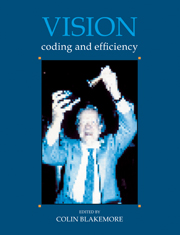Book contents
- Frontmatter
- Contents
- List of Contributors
- Preface
- Reply
- Acknowledgements
- Concepts of coding and efficiency
- Efficiency of the visual pathway
- Colour
- Brightness, adaptation and contrast
- Development of vision
- Depth and texture
- 26 Is there a single, most-efficient algorithm for stereopsis?
- 27 Binocular mechanisms in the normal and abnormal visual cortex of the cat
- 28 Viewing geometry and gradients of horizontal disparity
- 29 Texture discrimination: radiologist, machine and man
- Motion
- From image to object
- Index
27 - Binocular mechanisms in the normal and abnormal visual cortex of the cat
Published online by Cambridge University Press: 05 May 2010
- Frontmatter
- Contents
- List of Contributors
- Preface
- Reply
- Acknowledgements
- Concepts of coding and efficiency
- Efficiency of the visual pathway
- Colour
- Brightness, adaptation and contrast
- Development of vision
- Depth and texture
- 26 Is there a single, most-efficient algorithm for stereopsis?
- 27 Binocular mechanisms in the normal and abnormal visual cortex of the cat
- 28 Viewing geometry and gradients of horizontal disparity
- 29 Texture discrimination: radiologist, machine and man
- Motion
- From image to object
- Index
Summary
Introduction
We have considered the following three questions regarding the physiological organization of binocular pathways in the visual cortex of the cat. First, what are the rules by which signals from left and right eyes are combined in the visual cortex? Second, how are these rules affected when normal visual experience is prevented during an early stage of development? Third, how early in the development process is the physiological apparatus for binocular vision established?
These questions have been examined by use of a technique that differs from other physiological procedures that have been employed to study binocular vision. The major feature of our method is use of large, bright, sinusoidal gratings which are varied in relative phase between the two eyes so that retinal disparity is systematically changed. Aside from the analytical advantage of this stimulus, the large spatial extent of the gratings increases the likelihood that receptive fields are stimulated. We have found, for example, that 56% of cortical cells in normal cats exhibit disparity- dependent binocular interaction. In another study in which a thorough examination was made of binocular properties of cortical cells by use of single bars of light, only 37% displayed disparity selectivity (Ferster, 1981).
With respect to the questions we have addressed, our results are as follows. First, most simple cells and around half the sample of complex cells show phase-specific binocular interaction. This leads to the conclusion that most binocular interaction in striate cortex can be accounted for by linear summation of signals from each eye.
- Type
- Chapter
- Information
- VisionCoding and Efficiency, pp. 291 - 301Publisher: Cambridge University PressPrint publication year: 1991



